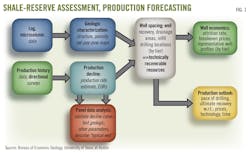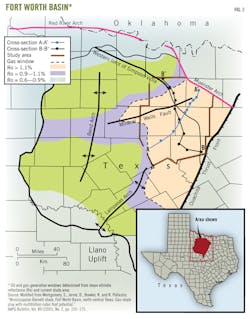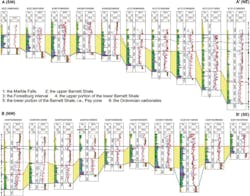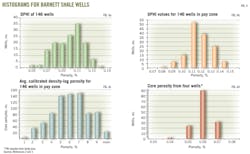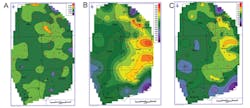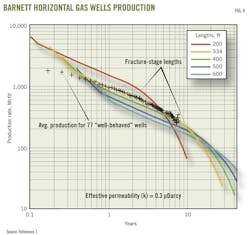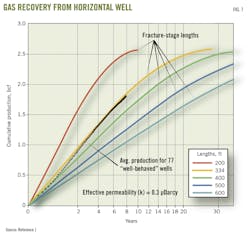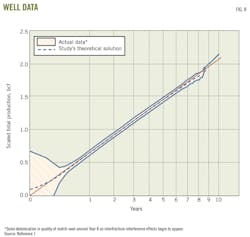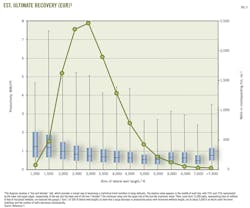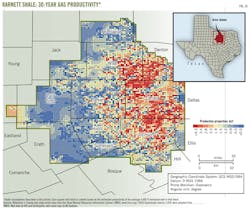BARNETT SHALE MODEL-1: Study develops decline analysis, geologic parameters for reserves, production forecast
John Browning, Scott W. Tinker, Svetlana Ikonnikova, Gürcan Gülen, Eric Potter, Qilong Fu, Susan Horvath, Tad Patzek, Frank Male, William Fisher, Forrest Roberts University of Texas
Austin
Ken Medlock III
Rice University
Houston
A comprehensive study of the reserve and production potential of the Barnett shale integrates engineering, geology, and economics into a numerical model that allows for scenario testing based on several technical and economic parameters. The study was conducted by the Bureau of Economic Geology (BEG) at the University of Texas at Austin and funded by the Alfred P. Sloan Foundation.
In its base case, the study forecasts a cumulative 45 tcf of economically recoverable reserves from the Barnett, with production declining predictably to about 900 bcf/year by 2030 from the current peak of about 2 tcf/year.
The forecast falls in the mid to higher end of other known predictions for the Barnett and suggests that it will continue to be a major contributor to US natural gas production through 2030.
This study by geologists, engineers, and economists resulted in a cohesive model of the Barnett, linking geologic mapping, production analysis, well economics, and development forecasting.
The study will be presented in two parts: Part 1 summarizes the geologic characterization, per-well production decline analysis, and productivity tiering required to feed into the detailed modeling of future reserve and production forecasts. The conclusion (OGJ, Sept. 2, 2013) examines full field economics and production and reserve forecasts.
Part 1 offers several unique contributions:
• Well-by-well analysis of production and calculation of estimated ultimate recovery (EUR) for all wells.
• Development of a physics-based decline curve that closely describes Barnett well declines.
• Drainage explained by linear transient flow, resulting in decline rates inversely proportional to the square root of time for the first 5-8 years and later exponential decline as a result of interfracture interference within the well drainage volume.
• Subdivision of the field into 10 productivity tiers, providing much-improved granularity for reserve forecasting and economics.
• Geologic mapping of porosity (PhiH) and net pay-zone thickness across the entire play. PhiH was determined to be a key driver of well productivity.
• Calculation of volumetric original free gas in place (OGIPfree) of 444 tcf for the 8,000-sq-mile study area.
• Technically recoverable resources for each square mile ranging from about 100 bcf/sq mile in the top tiers to less than 20 bcf/sq mile in the lower tiers, and field wide technically recoverable resources of about 86 tcf.
Study approach
The BEG study examines production data from all individual wells drilled 1995-2010 in the Barnett shale play in the Fort Worth basin. The study compares its 2050 production forecast to actual production through 2012. While other known assessments of the Barnett have relied on aggregated average production, offering a "top-down" approach to reserves and production forecasting, the BEG study takes a "bottom-up" approach, starting with the production history of every well then determining what remains to be drilled under various economic scenarios. The result is an unprecedented, comprehensive view of the field.
The study assesses natural gas and liquid production potential in 10 productivity tiers and uses them to forecast future production. Development economics vary widely across the basin as a function of production quality and liquids content.
The study's model accounts for this granularity, allowing for variations in natural gas price, drilling cost, gas plant processing economics, recovery factors (RFs) for each well, economic limit of each well, advances in technology, and many other geologic, engineering, and economic parameters to determine how much natural gas operators in the field will be able to extract economically from future wells.
Thickness and porosity affect reserves greatly, and natural gas and liquids prices are major factors affecting production. The model suggests that sensitivity to price is not overly dramatic, at least in the first several years of a formation's development, because many locations remain to be drilled in the higher-quality productivity tiers and higher-liquids regions.
A new method of estimating ultimate production for each well, based on the physics of the system rather than on mathematical decline-curve fitting, is integral to the project and should offer a more accurate method of forecasting production declines in shale wells in other basins.1
Our Barnett shale study, which began in mid-2011, uses 15,144 wells whose production is through mid-2011 for the purpose of tiering and decline-curve analyses. In the production outlook model, we forecast field development 2011-30 and run production forecasts through 2050.
This approach allows us to benchmark our forecast against actual 2011-12 drilling and production results—an important vetting process. Although the model allows for countless scenarios, we report on a base case of $4/Mcf natural gas and other relatively moderate technical and economic assumptions.
The base-case model forecast 2,757 new wells would be drilled 2011-12 with a total of 3.90 tcf of natural gas produced during the period by existing and newly drilled wells. Actual field results for 2011 and 2012 were, respectively, 1,765 and 1,259 (3,024 total) new wells drilled and 2.09 and 2.07 tcf (4.16 tcf total) of natural gas produced from the field.
The Barnett shale study workflow (Fig. 1) was developed to allow iterative input from all disciplines, ultimately leading to a rigorous production outlook model. This result provides some level of confidence that the model and its underlying assumptions are reasonable, at least in the early years. A model update that will include all wells drilled through 2012 and their production through mid-2013 will be run in 2014.
Geologic characterization
We chose a study area to encompass the extent of previous drilling within known geologic boundaries of the field. A total of 8,000 sq miles was included, although only 4,172 sq miles had been tested by drilling through 2010. The Barnett thins to the west and south, and the boundaries of the study area were extended to include the conceivable developable extent (Fig. 2).
We performed a log-based assessment of the Barnett.2 Raster logs from 16,730 wells were available, 2,010 of which were deep enough to view the full Barnett section, and only 420 had both density and neutron-porosity logs.
Of these, 146 wells with good log quality and caliper (measure of hole quality) and good spatial distribution were selected. Major stratigraphic tops were picked in all wells, and the study focused on the lower Barnett, the target interval of the vast majority of production.
To the west the complete Barnett section is included in the pay zone, but to the east the Barnett is subdivided into upper and lower members by the Forrestburg limestone formation. The lower Barnett thickens near its east edge with the addition of lower-quality porosity zones and interspersed lime mudstones that could inhibit fracture growth during hydraulic-fracture completions.
In this area, only the lower part of the lower Barnett is included in the pay zone (Fig. 3).
Density-log porosities across the pay zone were analyzed so that, when aggregated, they yielded a distribution average of 11.6% porosity (Fig. 4). This average was compared with crushed-core porosity from 796 samples in four wells,3 yielding an average porosity of 6.0%. The study used the ratio of log and core porosities to create an adjustment factor of 52% to adjust density-log porosity to core-equivalent porosity.
Maps were developed of adjusted porosity across the field, in addition to maps of net pay-zone thickness. The two maps were combined into a PhiH map indicating reservoir volume. The porosity-thickness map was found to provide the best correlation to well productivity, a key element in predicting future field production from undeveloped areas of the field. PhiH is clearly driven by the influence of pay-zone thickness, rather than by more gradually varying porosity (Fig. 5).
We recognize that the geologic description could have been enhanced greatly by analysis of seismic data to identify faulting, karsting, and other anomalies across the field. Seismic analysis was beyond the scope of the study, however, and we think that PhiH mapping is adequate to explain the first-level geologic drivers of production and to predict productivity across the field. The 3D seismic would be more crucial at an individual-prospect level.
Production decline; economic analysis
The study conducted individual decline analysis on all 15,144 wells drilled through 2010 to determine their individual EURs.1 Some of the key input variables in the study included:
• Base-well declines.
• Effects of late-life deterioration in decline owing to interfracture interference within the well's drainage area.
• Effects of attrition, recognizing that a percentage of wells have been lost each year as a result of an economic limit below which wells were shut in, a maximum 25-year life for all wells and technology improvement.
The base case yields an expected lifetime EUR from 15,144 wells drilled through 2010 of 18.5 tcf. Forecast field cumulative production through 2012 is 12.1 tcf from a forecast 17,901 wells. The forecast is slightly less than actual total-field production through 2012 of 13 tcf and actual wells drilled of 18,821. These data provide some level of confidence that the model and its underlying assumptions are reasonable.
The study developed a well-production-decline method on the basis of linear transient flow in the reservoir,1 which resulted in a per-well production decline inversely proportional to the square root of time for the first 8-10 years of well life, followed by exponential decline as interfracture interference began to affect production.
This approach was matched against all wells individually and against the full population of wells, demonstrating a root mean squared deviation from square-root of time flow of 8.584 (+/- 0.039) Mcf for the mean horizontal well with no apparent refractures, closely conforming to the theoretical prediction (Fig. 6). We also examined cumulative production from the well as a function of the log of time (Fig. 7).
A theoretical solution would yield a straight-line increase of cumulative production vs. log time until interfracture boundary conditions were reached within the well-fracture pattern, resulting in the predicted gentle downturn. The full derivation developed for the study includes not only prediction of interfracture effects, but also effects of adsorbed-gas release in the formation, supplementing well production as reservoir pressures decline. Application of this method requires knowledge of Langmuir adsorption isotherms, which, for the Barnett, have relatively insignificant effects on production.
We normalized production from all 15,144 wells to the median EUR and then plotted cumulative production vs. log-time distribution, along with the study's theoretical solution (Fig. 8).
In addition, we conducted an independent econometric-data analysis of about 16,000 wells.4 Results of this panel analysis confirmed field-wide well decline rates consistent with those predicted by the study's decline model.
Across Barnett field, many wells have erratic production with unexplained production increases during their lifetime. Some of these increases likely result from secondary refracturing, commencement of artificial lift, compression additions, or other operational stimuli. Refracturing (refrac) occurs when an additional fracture treatment is performed on existing perforations or additional perforation intervals are added. Some analysts speculate that refracturing could be a significant additional source of reserves.
Our study mathematically identified and quantified stepwise changes in the month-to-month EUR calculation for the well, using both Chow test and a statistical forecast measurement error from the predicted trend where significant deviations were noted for visual inspection. This step was performed to distinguish between slope changes, perhaps due to neighbor interference, and intercept shifts, such as might result when a refrac occurs. The process resulted in identification of wells for visual inspection of the production data.
Because our study did not confirm each potential case of refracturing with a given operator, this result should be considered preliminary. Given that caveat, the total impact from the identified potential refractures was less than 2% of field production, and in most cases per-well economics do not justify the cost.
Reservoir quality tiering
Knowing the EUR and location for every well in the field allowed us to determine productivity distribution across the play.5 We chose to examine EUR instead of initial production rate or early-life production rate and analyzed well results using a 1-sq mile grid as the smallest geographic mapping element. The well population contained a variety of completion technologies that affect EUR. Therefore, we first analyzed the relationship between EUR and horizontal length and found that total EUR increases with horizontal well length.
Next we looked at the incremental EUR contributed by each additional 500 ft of horizontal well length. Our approach was to group the wells into bins of 500-ft increments (i.e., wells 1,000-1,500 ft length, then wells 1,500-2,000 ft, so forth). We found for each bin the average EUR/foot declined with horizontal length (Fig. 9).
Using this information we adjusted all horizontal wells to a normalized EUR as if they had been drilled a uniform length (a 4,000-ft horizontal well length was chosen to normalize the data). The normalized EUR for all wells was then subdivided into 300-ft long horizontal segments along the well path. Directional surveys for all wells were plotted, and all length-normalized EUR/foot values for 300-ft long segments within each block were averaged.
The resulting average length-normalized EUR/foot for each block allowed for a productivity ranking of all blocks having at least one productive well. These ranked blocks were then subdivided into 10 productivity tiers, with each tier containing the same number of blocks. These tiered blocks were then mapped, and the undrilled blocks were filled on the basis of mathematical interpolation, biased by PhiH, to yield a full-field productivity-tier map (Fig. 10).
Tiering indicates a core area of higher productivity in a pattern that closely corresponds to the PhiH map (Fig. 5), indicating that reservoir pore volume is a key driver of productivity and that, within PhiH, thickness has the greatest influence. We refer to this map as a rock-quality map because of this close correspondence.
That said, the reservoir has considerable heterogeneity, with better performance blocks interspersed with poorer performance blocks and sometimes even better performing wells next to poorer performing wells within the same block. The field flanks have relatively low productivity where the reservoir thins to the west and south. The maps indicate high reservoir quality underlying the city of Fort Worth, highlighting resources that would be challenging to develop.
Acknowledgements
This research was conducted within the Bureau of Economic Geology in the Jackson School of Geosciences at the University of Texas at Austin. The research team consisted of the authors as well as Likeleli Seitlheko and Katie Smye. We thank IHS and DrillingInfo for access to their databases. We also thank members of the US Energy Information Administration's Office of Petroleum, Natural Gas & Biofuels Analysis for thoughtful reviews of the manuscript.
References
1. Patzek, T.W., Male, F. and Marder, M., "Simple models for gas production from hydrofractured shales," AAPG Bulletin, publication date to be announced.
2. Fu, Q., Horvath, S., Potter, E., Roberts, F., Tinker, S. W., Ikonnikova, S., Fisher, W., and Yan, J., "Log-based thickness and porosity mapping of the Barnett shale Play, Fort Worth Basin, Texas: A proxy for reservoir quality assessment," AAPG Bulletin, publication date to be announced.
3. Kale, S.V., Rai, C.S., and Sondergeld, C.H., "Petrophysical Characterization of Barnett shale," SPE Unconventional Gas Conference, Pittsburgh, Pa., Feb. 23-25, 2010.
4. Medlock III, K.B., and Seitlheko, L., "Panel data analysis of Barnett shale production," under review.
5. Ikonnikova, S., Browning, J., Horvath, S., and Tinker, S. W., "Well Recovery, Drainage Area, and Future Drill-well Inventory: Empirical Study of the Barnett shale Gas Play," SPE Reservoir Evaluation & Engineering, under review.
The authors
Scott W. Tinker ([email protected]) is the director of the Bureau of Economic Geology at the University of Texas at Austin, the State Geologist of Texas, and holds the Allday Endowed Chair and is acting Associate Dean of Research in the Jackson School of Geosciences at the university. He spent 17 years in the oil and gas industry before joining UT in 2000. He is past president of American Association of Petroleum Geologists, Association of American State Geologists, and Gulf Coast Association of Geological Societies. He is a Geological Society of America Fellow and holds appointments on the National Petroleum Council and Interstate Oil and Gas Compact Commission among other boards. Tinker holds a PhD in geological sciences from the University of Colorado, an MS in geological sciences from the University of Michigan, and a BS in geology and business administration from Trinity University.
John Browning ([email protected]) has been a senior research fellow since 2010 at the BEG, having retired from ExxonMobil after 33 years. He holds a BS (1977) in mechanical engineering from the University of Tennessee.
Svetlana Ikonnikova ([email protected]) is a research associate and energy economist in the BEG. She holds an MS (2003) in applied mathematics and physics from the Moscow Institute of Physics and Technology, Moscow, and a PhD (2007) in economics from Humboldt University of Berlin.
Gürcan Gülen ([email protected]) is a research associate and energy economist at the BEG in Houston. He is a member of the United States Association of Energy Economics (USAEE), the International Association of Energy Economics, and the Society of Petroleum Engineers. He holds a PhD (1996) in economics from Boston College and a BA (1990) in economics from Bosphorus University in Istanbul.
Tadeusz Patzek ([email protected]) is the Lois K. and Richard D. Folger Leadership Professor and chair of the Petroleum and Geosystems Engineering Department at the University of Texas at Austin. He also holds the Cockrell Family Regents Chair No. 11. He was professor of geoengineering at the University of California, Berkeley, 1990-2008, and before that was a researcher at Shell Development for 7 years. Patzek is a member of the Ocean Energy Safety Advisory Committee for the US Department of Interior's Bureau of Safety and Environmental Enforcement and of the SPE. Patzek holds an MS (1974) and PhD (1980) in chemical engineering from the Silesian Technical University in Poland.
Eric Potter ([email protected]) is program director for energy research at the BEG, joining in 2001 after 25 years with Marathon Oil Co. as an exploration geologist and as geoscience technology manager at Marathon's technology center in Denver. He holds a BA (1972) in earth science from Dartmouth College and an MS (1975) in geology from Oregon State University.
Qilong Fu ([email protected]) is a geologist with the BEG, joining in 2008. He holds a BS in geology from the Changchun College of Geology (Jilin University) in China, an MS in geology from the Institute of Geology, Chinese Academy of Sciences, and a PhD in geology from the University of Regina, Sask.
Susan Horvath ([email protected]) is a research scientist associate at the BEG. Previously, she worked as a GIS analyst for the Arkansas Geological Survey. She holds a BS (2002) and an MSc (2007) in geographic information systems from Eastern Michigan University. She is a member of AAPG, the Urban and Regional Information Systems Association, and Supporting Women in Geography and GIS.
Kenneth B. Medlock III ([email protected]) is James A. Baker III and Susan G. Baker Fellow in Energy and Resource Economics at the James A. Baker III Institute for Public Policy and senior director of the Baker Institute's Center for Energy Studies at Rice University, Houston. He is also vice-president of academic affairs for the USAEE. Medlock holds a PhD (2000) in economics from Rice University.
Frank Male ([email protected]) is a graduate student in the Center for Nonlinear Dynamics and the Department of Physics at the University of Texas at Austin. Before joining the university in 2010, he worked with the Max Planck Institute for Dynamics and Self-Organization in Göttingen, Germany, as a computational microfluidics researcher. Male holds a BS in physics and BA (2009) in political science from Kansas State University.
Forrest Roberts ([email protected]) is a graduate research assistant at the BEG, working on an MS in geology. He worked as a geology intern with Apache Corp. in Houston during summer 2012. He holds a BS (2011) in geological sciences from Brigham Young University and is a member of the AAPG and the Society of Exploration Geophysicists.
William L. Fisher ([email protected]) holds the Barrow Chair of Mineral Resources and is a professor in the department of geological sciences, University of Texas at Austin. He formerly served as director of the BEG, director of the Geology Foundation, and dean of the Jackson School of Geosciences, all of the University of Texas at Austin. Fisher holds a BS and DSc (Hon.) from Southern Illinois University, an MS and PhD in geology from the University of Kansas, a Deng (Hon.) from the Colorado School of Mines, and received the Presidential Citation (equivalent to an honorary doctorate) from the University of Texas at Austin.
